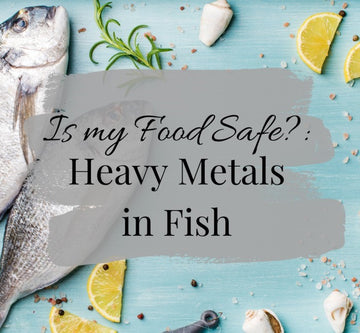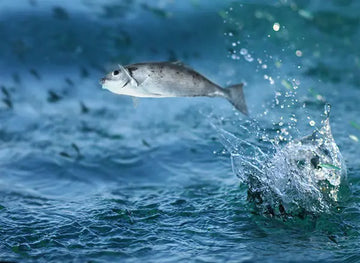What are Heavy metals & How do they get added into our Aquatic Ecosystem?
Heavy metals are metals that have a density of above 5mg/cm3 and negatively affect life in any form. They are harmful when they exceed threshold limits. (WHO 2011). Heavy metals occur during natural processes such as erosion, volcanism, and weathering. Heavy Metals are also obtained during anthropogenic activities that take place in the, industry, mining, metal smelting, oil refining, agriculture, fertilization and drainage. Living organisms require trace amounts of heavy metals, including cobalt, copper, manganese, and zinc to survive. However, excessive metal levels can be detrimental to the organism. Other heavy metals such as mercury, lead, and cadmium are not vital to organisms, and their accumulation over a long period in the body can cause serious illness or death.
Why is it Important to Consume Fish for our Good Health ?
The consumption of fish is recommended because fish is a basic and good nutritious food that has omega-3 fatty acids due to its cardioprotective effects. This present environment accounts for the presence of heavy metals in fish and the effect of toxic metals on human health.
How do heavy metals enter fish?


Fig: Heavy metals testing in seafood from marine sources.
Fish are commonly situated at the top of the food chain and are considered as susceptible aquatic organisms to toxins present in water. The increasing importance of aquatic food including fish as protein sources extended the focus on aquatic ecosystems. In recent years, much attention has been focused on the levels of Heavy Metals in fish and other foods to determine the hazardous effects of Heavy Metals on human health. Heavy Metals can enter into water bodies and aquatic ecosystems through drainage, atmosphere, soil erosion, and all human activities in different ways. Contaminants including Heavy Metals enter fish bodies: via gills, nonfood particles, skin, and oral consumption of water. These metals concentrate on different contents in the organs of fish body. Some metals such as iron, copper, zinc, and manganese are essential for biological systems such as enzymatic activities, whereas other Heavy Metals like arsenic, lead, cadmium, and tin have no known important role in living organs and are toxic even in trace amounts. Essential metals are taken up from water, food, or sediment by fish for their normal metabolism. These metals can also have adverse and toxic effects at high concentrations.
Different heavy metals and their impact on human health.
- Manganese (Mn)
Manganese (Mn) is an element of low toxicity that has considerable biological significance due to its ability to prevent heart attack, stroke, and cardiac arrest. Deficiency of Mn gave congenital malformations in offspring, poor growth performance, and low efficiency of the reproductive system. Manganese can become dangerous and toxic at high concentrations and usually may lead to neurologic and psychological disorders.
- Nickel (Ni)
Nickel (Ni) is an essential metal and occurs at very low levels in the environment. The deficiency of Ni in humans has not been documented. Ni is known to be carcinogenic. Moreover, fibrosis, tumors, lung inflammation, and emphysema are also caused by Ni.
- Iron (Fe)
Iron (Fe) is a mineral essential for every living cell and necessary for the synthesis of myoglobin, hemoglobin, and certain enzymes. Deficiency of Fe results in weakness, susceptibility, and inability to concentrate. Anderson and Fitzgerald studied that one of the most common nutrient deficiencies in the world is Fe deficiency in anemia such as malaria. Anemia disease gives poor performance in circulatory transport and also reduces oxygen supply to muscles, less efficiency due to the decreasing of myoglobin content and impairing endurance capacity.
- Chromium (Cr)
Chromium (Cr) is an essential trace element in some animals and humans. Cr reduces body fat and also improves lean body mass. The effects of Cr in body are small compared to those of a well-balanced diet and exercise. But it could have an undesirable fatal effect in excess amounts. Lack of Cr can affect the growth and disturbances in glucose, lipid, and protein metabolism.
- Zinc (Zn)
Zinc (Zn) is a ubiquitous trace element and one of the essential elements that is important to humans and plants. Zn is known as a cofactor to more than 300 enzymes that are involved in RNA and DNA metabolism. Zn is also important in the structure stabilization of a large number of proteins. When exceeding amounts are present, Zn becomes toxic but a deficiency of Zn can lead to several disorders such as results in poor pregnancy outcomes and the development of chronic diseases, including cardiovascular disease, and also cause cancer.
- Copper (Cu)
Copper (Cu) is an essential metal of enzymes and is necessary for hemoglobin synthesis. Impaired delivery of Cu can result in decreased cuproenzyme activity, in the skeletal and vascular systems and also cause anemia, neutropenia, and osteoporosis. Impaired metabolism of Cu could cause two genetic diseases which are Mense disease and Wilson disease. Accumulation of Cu can expose to Mense disease which is a fatal disorder. Wilson disease also could occur due to Cu accumulating in the brain and eyes. Excessive intake of Cu also could cause kidney damage and even death.
- Mercury (Hg)
Mercury (Hg) is a non-essential element. The levels of Hg increase due to the increases in fish size. The toxicity of Hg can damage the organ in fish and, in humans, Hg can cause the development of a fetus destroyed due to its toxicity and also considered a carcinogen. Hg is a human toxicant and becomes a primary source of humans by eating fish.
- Cadmium (Cd)
Food consumption is a main source of exposure to cadmium (Cd) in the human body. Cd is known as an endocrine disturbing substance and it is well documented that Cd can cause to development of breast cancer and prostate cancer in humans. The Cd also causes damage in the kidney, hypertension, tumors, poor reproductive performance, and hepatic dysfunction.
- Lead (Pb)
Lead (Pb) is a naturally occurring and industrially produced element that is very toxic to humans, especially children. Children are the most vulnerable to Pb because they have less effective renal excretion and greater absorption of gastrointestinal. The fetal brain presents a greater sensitivity to the toxic effects of Pb compared to the mature brain. Symptoms like intestinal cramps, anemic condition, and fatigue caused by poisoning of Pb.
- Arsenic (As)
Arsenic (As) is widely spread in the environment due to both natural and anthropogenic processes. As is a carcinogen and potent toxicant. As also has the potential to destroy communities of ecological systems. Toxicity of As depends on the speciation and trivalent.
How is VTF safe from heavy metals?
VTF ensures that the fish are farmed in water which is free from the presence of pollution or heavy metals. At VTF, fish biologist continuously evaluates and monitors the water quality, and fish sampling is done to ensure the fish is free from heavy metals presence and is 100% safe for the customers.


Fig: VTF Bio Secured farms 100% safe and free from presence of heavy metals.

Fig: Sampling of fish for checking heavy metal presence from farm.
Bibliography
- https://www.researchgate.net/publication/283471216_Heavy_metal_in_fish_Analysis_and_human_health-a_review
- http://correctbodymaintenance.com.au/heavy-metal-toxicity-fish-to-avoid/
- https://acquanyc.com/is-my-food-safe-heavy-metals-in-fish.html
Prepared by
Abin S.N
(MSc Industrial Fisheries and Fish Biologist)





